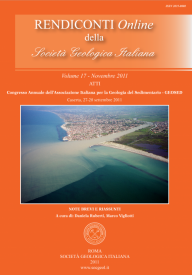
Stratigrafia fisica della successione sedimentaria miocenica del settore Nord-orientale della Stretta di Catanzaro (Calabria centro-orientale)
Cianflone G. (*) & Dominici R. (*)
(*) Dipartimento di Scienze della Terra, Università della Calabria, Via P. Bucci Cubo 15B, 87036 Arcavacata di Rende (CS). E-mail: dominici@unical.it
Volume: 17/2011
Pages: 63-69
Abstract
Physical Stratigraphy of the upper Miocene sedimentary succession in the northeastern Catanzaro Through (Central Calabria, Italy).
In the northeastern sector of the Catanzaro Trough, a terrigenous, evaporitic and carbonate mio-pliocenic sedimentary succession overlies the igneous-metamorphic basement of the Sila Unit. These deposits are strongly controlled by NW- strike-slip system, arranged in a right-hand en échelon pattern (Tansi et alii, 2007). Coarse-grained fluvial deposits of the Corace conglomerate Unit represent the onset of the Serravallian – Tortonian sedimentation. Overlying shallow marine arenites and calcarenites, including Porites bodies, pass upward to offshore marly-clays deposits of the Gagliano Unit, evolving upsection to diatomite and organic-rich laminites (Tripoli Fm.) at the Tortonian/Messinian boundary. Evaporitic conditions characterized the sedimentation within the Mediterranean basin during the Messinian as demonstrated by the wide distribution of selenite, micrite and halite deposits.
In the northeastern sector of the Catanzaro Trough such conditions are recorded by fi ne grained carbonate deposits, of assumed bacterial origin (Guido et alii, 2007), and can be correlated to CdB type 2 by Manzi et alii (2010), developed during the fi rst MSC stage, from 5,96 Ma to 5,6 Ma. Chaotic deposits of selenitic blocks, gypsrudites and gypsarenites (resedimented evaporites; sub-unit 1 of Riato Conglomerate) and limestone breccias (CdB-2) overlie the Tripoli Fm. along a paraconcordance surface and characterize the depocentral area. The chaotic deposits pass upward to sub-unit 2 of Riato Conglomerate and Arieste Fm characterized by channels and bars facies. They show a fi ning and thinning upward trend represented by a drastic decrease of the intrabasinal evaporitic and carbonate alimentation in favour of metamorphic and plutonic detritus supplied by the Calabrian-Peloritan Arc units.
The development of a coarse grained fl uvial-deltaic depositional system characterizes the MSC fi nal stage. Towards the depocentre continental sediments pass to clayey-sandy deposits, containing biofacies with ostracods (Lago Mare) and selenitic bodies with banded and massive facies, referred to Upper Evaporites (Costa, pers. Comm.) The sedimentary succession exposed in the northeastern sector of the Catanzaro Through defi nes a depositional architecture that may be included in the evolution model proposed by Roveri et alii (2008). In this contest the chaotic and terrigenous-evaporitic-carbonate deposits (sub-units 1-2 of the Riato Conglomerate, CdB-2 and Arieste Fm.), originated by the cannibalism of the selenite and carbonates deposits probably between 5.6 and 5.55 Ma, record a gradual return to a extrabasinal alimentation originated by the erosion of the Serravallian and Tortonian sedimentary units and crystalline rocks of the Sila Unit.
Keywords
Get Full Text